|
|
|
Sort Order |
|
|
|
Items / Page
|
|
|
|
|
|
|
| Srl | Item |
| 1 |
ID:
153715
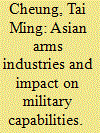

|
|
|
|
|
| Summary/Abstract |
This paper shows how alliance networks have affected defence industrialization policies and processes in countries in the Asia-Pacific region. In countries that enjoyed security assurances from the United States like Japan and South Korea, they are primarily focused industrialization and technology development in civilian sectors, and consequently, defence industrialization is a secondary priority. On the other hand, defence industrialization was/is of higher priority for states that face acute security threats such as China and the Democratic People’s Republic of Korea. In contemporary industrialization processes, the paper concludes that the preference between commercial and defence industrialization is now closing, leading towards an integrated model from which both sectors can benefit.
|
|
|
|
|
|
|
|
|
|
|
|
|
|
|
|
| 2 |
ID:
105079
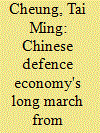

|
|
|
|
|
| Publication |
2011.
|
| Summary/Abstract |
China's defense economy has been vigorously developing a comprehensive set of innovation capabilities that will eventually allow it to join the world's top tier of military technological powers. China's target is to catch up by 2020. Although this maybe possible in a few select areas, the defense economy as a whole will likely require another decade or more to successfully master the ability to produce major innovations of a radical nature. This paper analyzes the key areas in the Chinese defense economy's gradual but accelerating shift from imitation to indigenous innovation.
|
|
|
|
|
|
|
|
|
|
|
|
|
|
|
|
| 3 |
ID:
182628
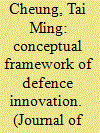

|
|
|
|
|
| Summary/Abstract |
Gaining a decisive technological edge is a never-ending pursuit for defence establishments. Intensifying geo-strategic and geo-economic rivalry among major powers, especially the U.S and China, and the global technological revolution occurring in the civilian and military domains, promise to reshape the nature and distribution of global power. This article provides a conceptual framework for a series investigating the state of global defence innovation in the twenty-first century. The series examines defence innovation in small countries with advanced defence innovation capabilities (Israel, Singapore), closed authoritarian powers (North Korea, Russia), large catch-up states (China and India) and advanced large powers (U.S.).
|
|
|
|
|
|
|
|
|
|
|
|
|
|
|
|
| 4 |
ID:
142795
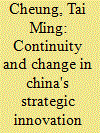

|
|
|
|
|
| Summary/Abstract |
The development of strategic technology capabilities, especially in the defense and national security-related domains, is one of the highest priorities of the Chinese authorities in the 21st Century and is regarded as a core pillar of China's rising national power and prestige. At the center of efforts to develop these core technologies is the strategic innovation system, which is made up of an elite collection of major organizational actors that straddle across the political, economic, industrial, national security, and science and technology systems. This article examines the rise, decline, and re-emergence of the Chinese strategic innovation system over the past six decades. Key topics that are scrutinized include the defense industry, the 863 High-Technology Research and Development Program, the 2006-2020 Medium- & Long-Term Science and Technology Development Plan, and the Strategic Emerging Industries initiative.
|
|
|
|
|
|
|
|
|
|
|
|
|
|
|
|
| 5 |
ID:
086248
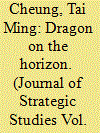

|
|
|
|
|
| Publication |
2009.
|
| Summary/Abstract |
China's grand ambition is to become a world-class military industrial power by 2020, but can it succeed? A concerted restructuring of the defense industry is taking place to tackle deep-seated obstacles constraining its ability to absorb, create and diffuse technological innovation. This includes promoting competition and creativity by reducing the reach of the state and encouraging enterprises to play a leading role, developing a robust regulatory and standards regime to provide benchmarks and rules, and forging integration between the civilian and military portions of the economy through spin-ons.
|
|
|
|
|
|
|
|
|
|
|
|
|
|
|
|
| 6 |
ID:
104845
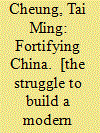

|
|
|
|
|
| Publication |
Ithaca, Cornell University Press, 2009.
|
| Description |
xvi, 279p.
|
| Standard Number |
9780801446924, hbk
|
|
|
|
|
|
|
|
|
|
|
|
Copies: C:1/I:0,R:0,Q:0
Circulation
| Accession# | Call# | Current Location | Status | Policy | Location |
| 056110 | 338.473550951/CHE 056110 | Main | On Shelf | General | |
|
|
|
|
| 7 |
ID:
188694
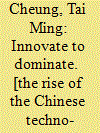

|
|
|
|
|
| Publication |
Ithaca, Cornell University Press, 2022.
|
| Description |
xiii, 400p.hbk
|
| Standard Number |
9781501764349
|
|
|
|
|
|
|
|
|
|
|
|
Copies: C:1/I:0,R:0,Q:0
Circulation
| Accession# | Call# | Current Location | Status | Policy | Location |
| 060306 | 338.951/CHE 060306 | Main | On Shelf | General | |
|
|
|
|
| 8 |
ID:
148218
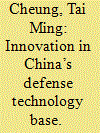

|
|
|
|
|
| Summary/Abstract |
China’s defense science, technology, and industrial system has been undergoing a far-reaching transformation over the past two decades and the single biggest factor behind this turnaround is the role of external technology and knowledge transfers and the defense industry’s improving ability to absorb these inputs and convert into localized output. China is pursuing an intensive campaign to obtain defense and dual-use civil–military foreign technology transfers using a wide variety of means, which is explored in this article.
|
|
|
|
|
|
|
|
|
|
|
|
|
|
|
|
| 9 |
ID:
182629
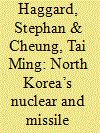

|
|
|
|
|
| Summary/Abstract |
North Korea’s strategic weapons innovation system is exemplary of an authoritarian mobilization model. The top leadership prioritizes the program and mobilizes the country’s science, technology, and heavy industrial resources around key programs. Key to success are investments in a defense industrial infrastructure that runs from basic research and development to applied R&D, product development, and linked production capability. Although foreign borrowing is important, the country’s nuclear and missile programs would not have gelled in the absence of complementary domestic investments.
|
|
|
|
|
|
|
|
|
|
|
|
|
|
|
|
| 10 |
ID:
124769
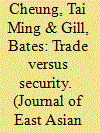

|
|
|
|
|
| Publication |
2013.
|
| Summary/Abstract |
Apart from a short period in the 1980s, the People's Republic of China has been almost completely excluded from access to military and sensitive dual-use civilian-military technologies from the United States and its allies. But in an era of globalization and convergence in the civilian and military technological domains, this compartmentalization of the economic and security arenas has become increasingly difficult to maintain and justify. Major trading countries are caught in the dilemma of balancing restrictions on high technology and other sensitive trade and investment with China against the benefits of deeper ties with the world's second-largest economy. In examining the trade-offs between economics and national security for the United States, the European Union, Israel, and Japan, it becomes clear that China's rise and growing economic and strategic influence introduce new complexities and challenges for controlling militarily relevant technology and knowledge transfers.
|
|
|
|
|
|
|
|
|
|
|
|
|
|
|
|
|
|
|
|
|